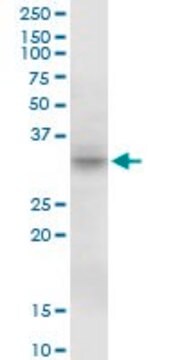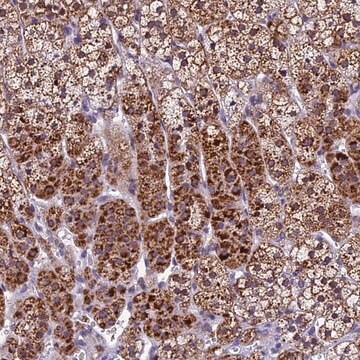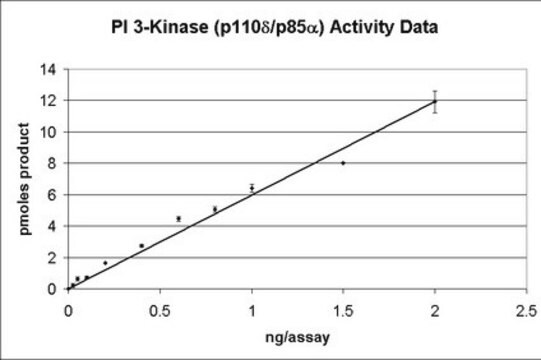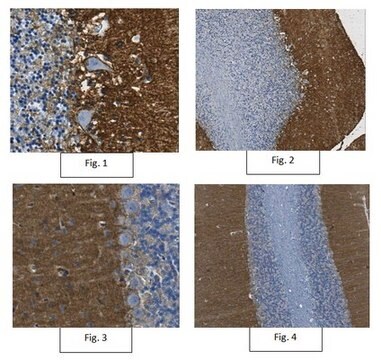General description
3-mercaptopyruvate sulfurtransferase (EC 2.8.1.2; UniProt P25325; also known as MpST, MST, tRNA thiouridine modification protein, TUM1) is encoded by the MPST (also known as TST2) gene (Gene ID 4357) in human. 3-mercaptopyruvate sulfurtransferase (MpST) catalyzes the transfer of a sulfur ion to cyanide or other thiol compounds and plays a central role in both cysteine degradation and cyanide detoxification. MpST is also known as tRNA thiouridine modification protein (TUM1) and is implicated in other cellular processes in addition to cyanide detoxification, ranging from thiolation of cytosolic tRNAs to the generation of H2S as signaling molecule both in mitochondria and the cytosol. Chronic cyanide intoxications caused by cyanogenic substances present in food products can lead to neurological disorders. MpST and rhodanese [EC 2.8.1.1] are two enzymes that catalyze cyanide detoxification, with MpST also displaying weak rhodanese activity. Cyanide detoxification by rhodanese requires the presence of compounds bearing labile sulfane sulfur, while mercaptopyruvate is needed for MpST catalyzed reaction. Under oxidative stress conditions, the catalytic cysteine site is converted to a sulfenate, resulting in an inactivation of MpST enzymatic activity. Reduced thioredoxin reactivates the enzyme by cleaving an intersubunit disulfide bond to turn the redox switch on. Aberrant MpST activity is found in a few cases of mercaptolactate-cysteine disulfiduria (MCDU) characterized by the appearance of large quantaties of the sulfur-containing amino acid, beta-mercaptolactate-cysteine disulfide, in the urine.
Specificity
Clone 1H10.1 targets an epitope in the second Rhodanese domain present in both spliced isoforms of human MPST reported by UniProt (P25325).
Immunogen
Epitope: Second Rhodanese domain.
GST-tagged recombinant fragment from the second Rhodanese domain of human MPST.
Application
Research Category
Signaling
Research Sub Category
Toxicology & Drug Resistance
This Anti-MPST Antibody, clone 1H10.1 is validated for use in Western Blotting, Immunohistochemistry (Paraffin) for the detection of MPST.
Western Blotting Analysis: 0.5 µg/mL from a representative lot detected MPST in 10 µg of human liver tissue lysate.
Immunohistochemistry Analysis: A 1:50 dilution from a representative lot detected MPST in human heart and kidney tissue sections.
Quality
Evaluated by Western Blotting in SHSY-5Y cell lysate.
Western Blotting Analysis: 0.5 µg/mL of this antibody detected MPST in 10 µg of SHSY-5Y cell lysate.
Target description
~33 kDa observed. 33.05 kDa (isoform 1) and 35.12 kDa (isoform 2) calculated (Met1 removed). Uncharacterized band(s) may appear in some lysates.
Physical form
Format: Purified
Protein G purified.
Purified mouse monoclonal IgG2aκ antibody in buffer containing 0.1 M Tris-Glycine (pH 7.4), 150 mM NaCl with 0.05% sodium azide.
Storage and Stability
Stable for 1 year at 2-8°C from date of receipt.
Other Notes
Concentration: Please refer to lot specific datasheet.
Disclaimer
Unless otherwise stated in our catalog or other company documentation accompanying the product(s), our products are intended for research use only and are not to be used for any other purpose, which includes but is not limited to, unauthorized commercial uses, in vitro diagnostic uses, ex vivo or in vivo therapeutic uses or any type of consumption or application to humans or animals.








